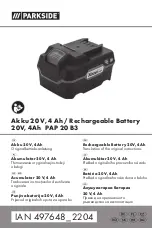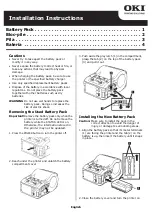
1
DOC PN 392-0210-Rev B
IMPORTANT SAFETY INSTRUCTIONS
SAVE THESE INSTRUCTIONS:
This manual contains
important safety and operating instructions for the Battery Tender®
Solar Charger and Solar Panels.
CAREFULLY READ THESE
INSTRUCTIONS BEFORE USING THE BATTERY CHARGER.
WARNING AND CAUTION LABEL DEFINITIONS:
WARNING
WARNING indicates a potentially hazardous situation, which, if
not avoided, could result in serious injury or death.
CAUTION
CAUTION indicates a potentially hazardous situation, which, if
not avoided, may result in minor or moderate injury.
CAUTION
CAUTION used without the safety alert symbol indicates a
potentially hazardous situation that if not avoided, may result in
property damage.
GENERAL PRECAUTIONS
WARNING
Battery posts, terminals and related accessories contain lead
and lead components, and other chemicals known to the State
of California to cause cancer and birth defects or other
reproductive harm. Always wash your hands after handling
these devices.
WARNING
Do not operate the battery charger with damaged DC input
cords or DC output cords or accessories - Replace Cords or
accessories immediately if damaged.
Battery Tender
£
Solar Junior
Battery Charger & Solar Panels
Designed for six cell lead-acid batteries
from 1.2 – 200Ah
2
CAUTION
WORKING WITH LEAD ACID BATTERIES AND BATTERY CHARGERS:
All lead acid batteries have the potential to emit gasses that may combine
into a combustible or explosive mixture. In many cases, it is possible that
lead acid batteries will emit these gasses during normal discharge and
charging operations. Because of this potential danger, it is important that
you follow the precautions recommended by both the battery and battery
charger manufacturers before using either one. For example, do not
exceed the recommended maximum recharge rate (charger output current
limit), or remove cell caps while charging flooded batteries.
CAUTION
CHARGER VOLTAGE COMPATIBILITY: NEVER
use a battery charger
unless the battery voltage matches the output voltage rating of the charger.
For example, do not use a 12-volt charger with a 6-volt battery and vice-
versa.
CHARGER LOCATION: LOCATE
the charger as far away from the
battery as is allowed by the length of the output cable harness.
NEVER
set
the charger above the battery.
NEVER
set the charger on a surface
constructed from combustible material.
NEVER
place the battery, the
charger, or any of the electrical connections between them in an area that
is likely to become wet.
EXCESSIVE MOISTURE:
Do not expose the battery charger or any of its
electrical connections to rain, snow, or extremely high, condensing
humidity.
CHARGER ATTACHMENTS:
Do not use attachments that are not
recommended or sold by the charger manufacturer. To do otherwise may
result in the risk of electric shock, fire, or possibly some other unforeseen
potential personal injury situations.
HANDLING POWER CORDS:
When handling electric power cords,
always pull by the plug rather than by the cord. This will reduce the risk of
damage to both the plug and cord, and it will minimize the likelihood of
electric shock resulting from that damage.
LOCATION OF POWER CORDS:
Make sure all electric power cords are
located so that they cannot be stepped on, tripped over, or otherwise
subjected to damage or stress.
MONITORING SEALED & NON-SEALED BATTERIES:
When leaving a
battery charger connected to either a sealed (AGM or GEL) or non-sealed
(flooded battery) for extended periods of time (weeks, months, etc.),
periodically check the battery to see if it is unusually warm. This is an
indication that the battery may have a weak cell and that it could go into a
thermal runaway condition. If the battery releases an excessive amount of
gas or if the battery gets hotter than 130
q
F (55
q
C) during charging,
disconnect the charger and allow the battery to cool. Overheating may
result in plate distortion, internal shorting, drying out or other damage. For
flooded batteries, also check individual cell fluid levels against
manufacturer's recommendations for safe operation.






















